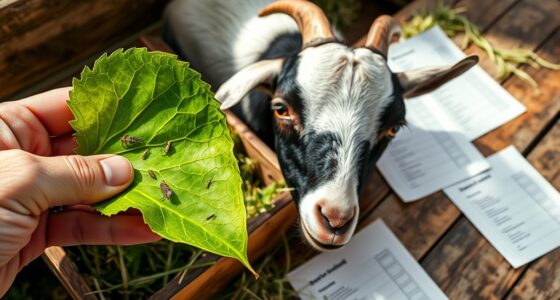To tell if your goat is pregnant, start by watching for early signs like weight gain, changes in behavior, and skipped heat cycles. You can confirm pregnancy through ultrasound, which detects it as early as 20 days. Keep an eye on mid-pregnancy indicators like increased appetite and udder development. As you get closer to kidding, look for udder swelling and restlessness. There's plenty more to know to ensure a smooth pregnancy journey, so keep exploring!
Key Takeaways
- Check for skipped heat cycles, indicating successful breeding and possible pregnancy.
- Monitor for early signs like weight gain, abdominal shape changes, and udder development.
- Use transrectal ultrasound or ultrasonography for early pregnancy detection around 20-30 days post-breeding.
- Observe behavioral changes, such as increased affection or restlessness, which may signal pregnancy.
- Look for late pregnancy signs, including noticeable udder swelling and significant weight gain in the month before kidding.
Understanding Pregnancy Confirmation Methods

When you're trying to confirm if your goat is pregnant, understanding the various methods available can make the process easier.
Ultrasonography is a reliable option, allowing you to visualize the embryo as early as 30 days post-breeding. If you prefer earlier detection, transrectal ultrasound can identify pregnancy as soon as 20 days, though it's more challenging.
Ultrasonography allows for embryo visualization as early as 30 days post-breeding, with transrectal ultrasound detecting pregnancy as soon as 20 days.
Biological tests like progesterone and estrone sulfate can also indicate pregnancy, with estrone sulfate remaining elevated throughout gestation.
For late gestation, radiography offers 100% accuracy after day 70, but it's less practical due to costs.
Ultimately, each method has its pros and cons, so choose the one that suits your needs best for accurate results.
Recognizing Early Signs of Pregnancy
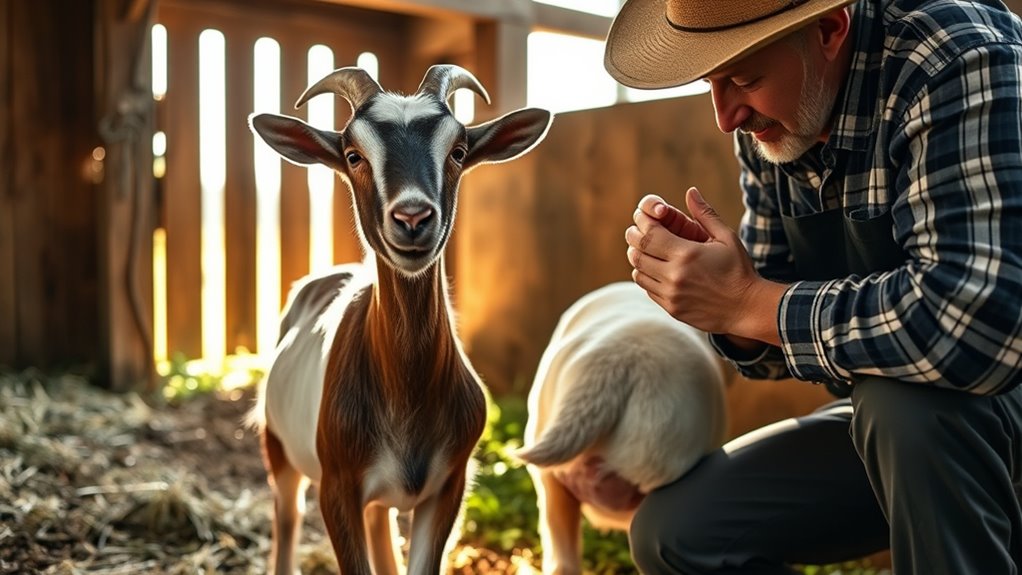
Recognizing early signs of pregnancy in your goat can be crucial for ensuring proper care and preparation. You might notice weight gain and a change in abdominal shape as her belly becomes rounder.
If you're milking her, watch for a decrease in milk production, and keep an eye out for any early udder development.
Behavioral changes can also indicate pregnancy; she may become more affectionate or restless, and you might hear more vocalizations or see her wagging her tail.
Most importantly, if she's been successfully bred, expect her to skip her heat cycles.
Keep track of her health and these signs to prepare for the exciting arrival of kids!
Identifying Mid-Pregnancy Indicators

As your goat's pregnancy progresses, you'll notice several mid-pregnancy indicators that can help you confirm she's expecting.
First, her appetite will likely increase, signaling her body's needs for the growing kids. If she's a lactating doe, you might see a decrease in milk production as her pregnancy advances.
Watch for physical changes, like a noticeably larger belly, especially if she's carrying multiple kids. You may also observe behavioral shifts, such as her becoming more reclusive or seeking extra attention.
Around three to four months in, you may even feel fetal movement. Keeping a close eye on these signs will ensure you're well-prepared for the next stages of her pregnancy.
Observing Late Pregnancy Signs

In the final weeks of your goat's pregnancy, you'll want to pay close attention to various late pregnancy signs that indicate she's nearing her due date.
First, watch for udder development; seasoned does often start swelling about a month before kidding. You might also notice an increased appetite and noticeable weight gain as the fetus grows.
Watch for udder swelling, increased appetite, and weight gain as your doe approaches her kidding date.
Behavioral changes can be significant—irritability and restlessness may arise as she approaches her due date. Physically, her abdomen will become more pronounced, making her appear larger.
Be mindful of her health; ensure she receives proper nutrition to avoid complications like pregnancy toxemia. Monitoring these signs will help you prepare for the arrival of her kids and ensure a smooth transition.
Labor Indicators to Watch For
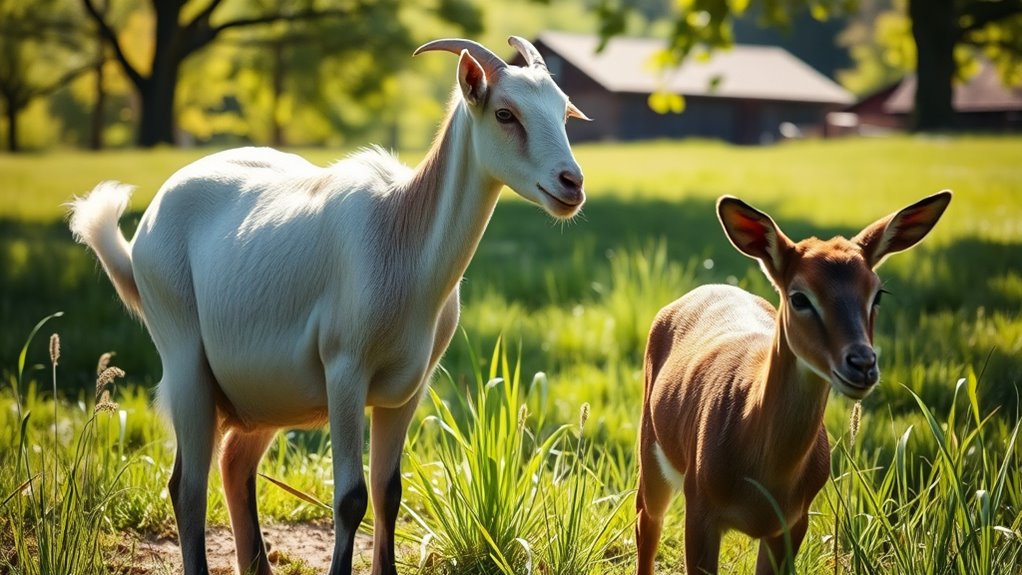
Knowing what to look for as your goat approaches labor can make a significant difference in ensuring a smooth delivery.
Watch for physical changes like udder development, vulva swelling, and pelvic ligament softening. Her belly will sag, and you might notice a thick mucus discharge.
Behaviorally, she may become restless, vocalize more, and seek solitude. Look for pre-labor activities such as pawing at the ground and increased movement.
During labor, expect visible contractions, the appearance of the water bag, and intensified discharge. Heavy panting, teeth grinding, and repeated lying down are signs of the final stages.
Stay attentive to these indicators to provide the support she needs during this critical time.
Importance of Post-Breeding Care
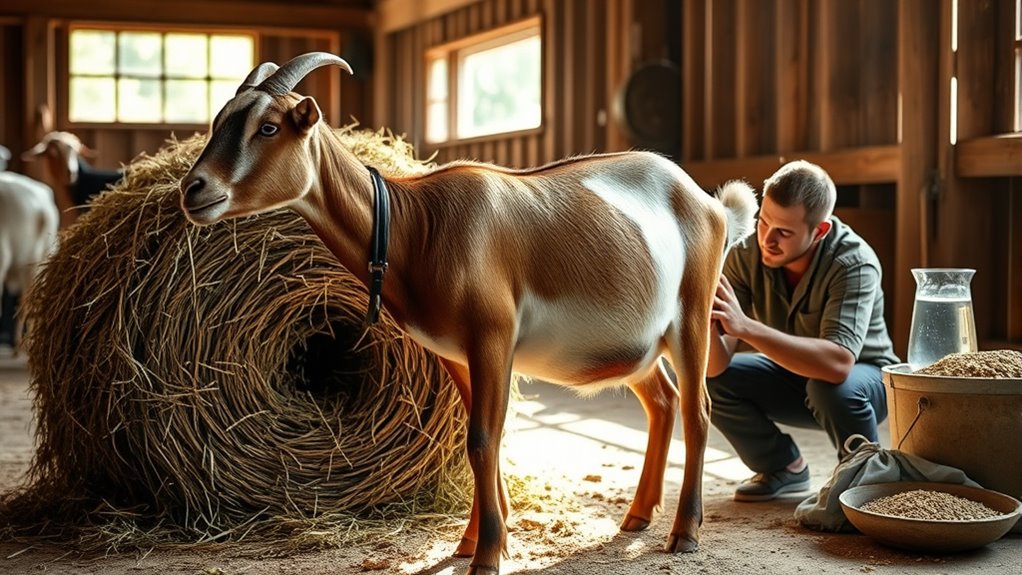
After ensuring your goat is ready for labor, the focus shifts to her care during pregnancy.
Stress reduction is crucial, so limit any changes to her routine and avoid travel in the early stages. Keep an eye on her health by regularly checking for signs of illness or infection.
Stress reduction is vital; maintain her routine and monitor her health for any signs of illness or infection.
Deworming is essential to control parasites, and make sure her vaccinations are up to date to protect her from diseases. Consulting with a veterinarian can provide personalized guidance tailored to her needs.
Maintaining an optimal body condition score and ensuring regular hoof care will support her as she carries her kids. A stable social environment will also help her feel secure during this critical time.
Nutritional Support for Pregnant Does
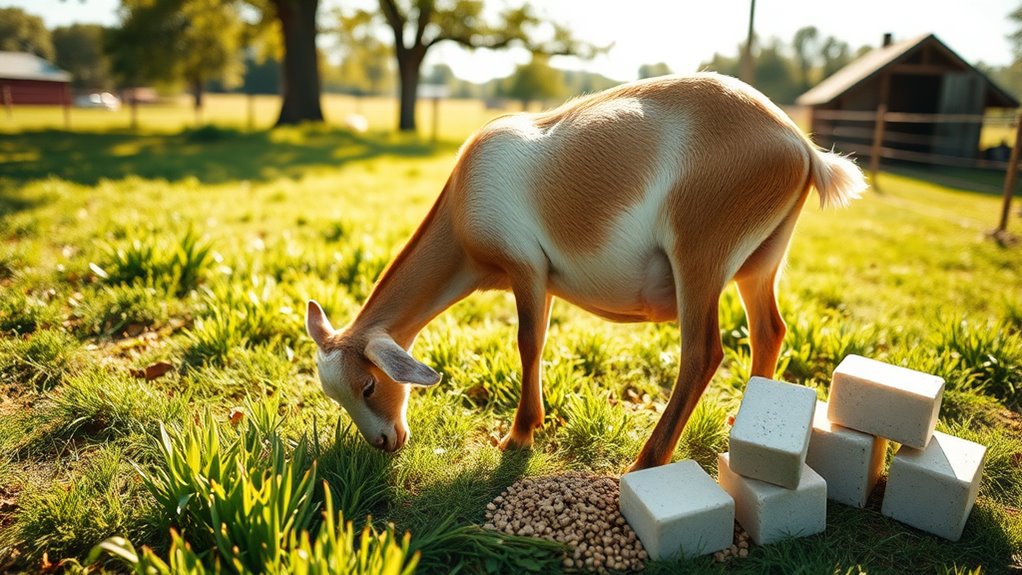
Providing proper nutritional support for pregnant does is essential for their health and the development of their kids. Focus on energy-dense diets that include high-quality forages like legume hays and consider grain supplements to boost energy intake, especially in the last trimester.
Protein is crucial too; aim for a diet containing 14% to 16% protein, using legume hays and protein supplements like soybean meal.
Ensure you provide a mineral mix tailored for goats, emphasizing calcium, phosphorus, and vitamins A and E.
Don't forget about hydration—fresh, clean water is vital for nutrient absorption.
Monitor your does' body condition to adjust their diet as needed, ensuring they remain healthy throughout their pregnancy.
Monitoring Health Throughout Pregnancy
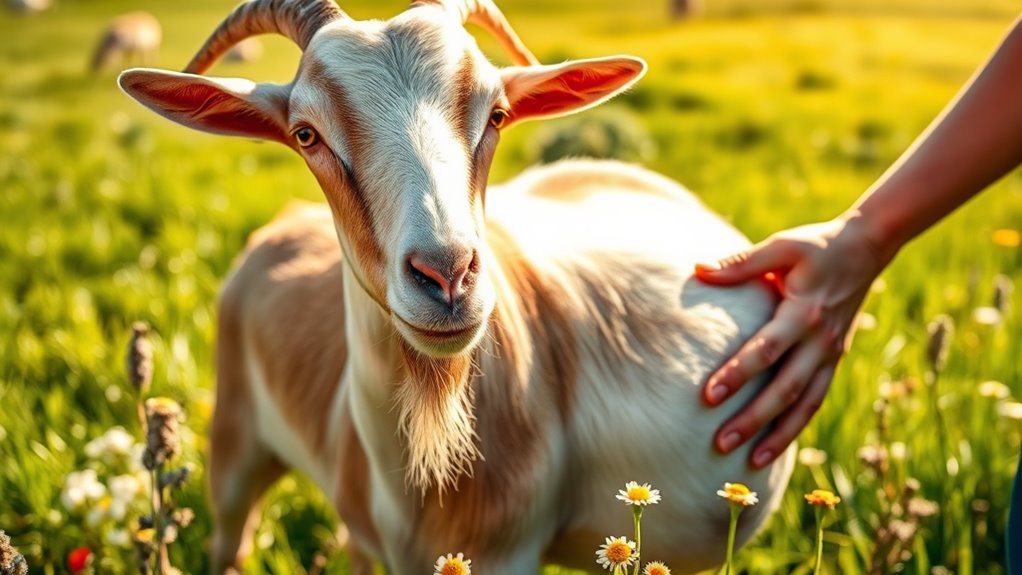
As your goat progresses through pregnancy, monitoring her health becomes crucial for both her well-being and the development of her kids.
Start by confirming her pregnancy through ultrasonography or blood tests like BioPRYN, ideally around 30 days post-breeding. Keep an eye out for signs of pregnancy, such as a failure to return to heat, increased appetite, and belly enlargement.
Regularly assess her udder development and watch for fetal movement around 3-4 months in. Manage health risks by maintaining a low-stress environment and implementing biosecurity measures.
Don't forget to consult your veterinarian for vaccinations and nutritional adjustments to ensure her and her kids' health throughout the pregnancy.
Preparing for Kidding and New Arrivals
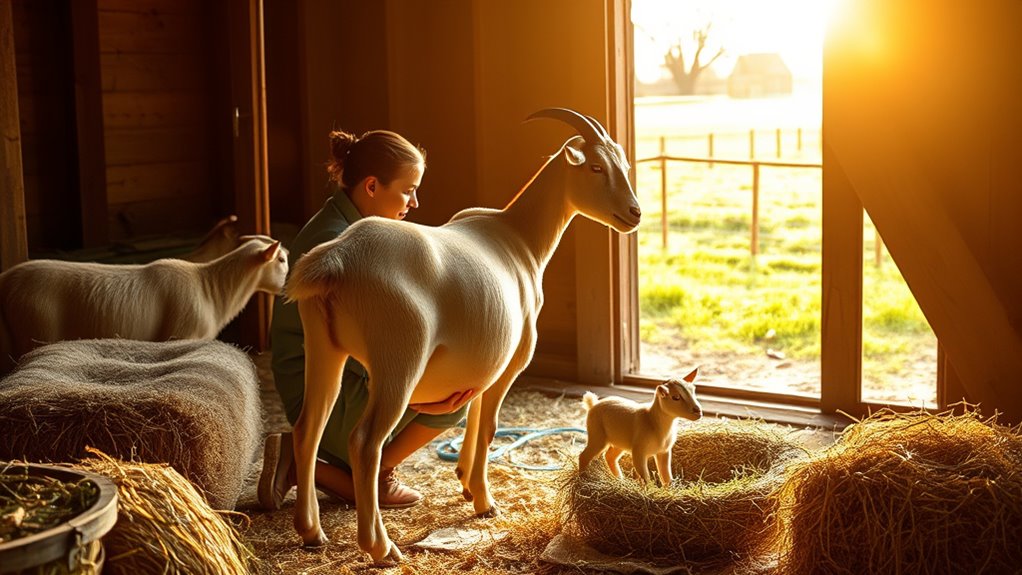
Preparing for the arrival of new kids can be an exciting yet challenging time, so it's essential to set up a safe and comfortable environment for your doe.
Start by cleaning and ventilating the birthing space, providing at least 16 square feet per newborn. Use clean, dry bedding to keep the area warm, and ensure adequate lighting, especially at night.
Gather essential supplies like towels, scissors, iodine tincture, and colostrum replacer. Post-delivery, offer warm water with molasses to the doe.
Be prepared for complications by having your vet's contact information handy and monitoring tools ready. Organize all supplies into a kidding kit and clear your schedule around the expected kidding date for your doe's needs.
Frequently Asked Questions
Can Goats Experience False Pregnancies?
Yes, goats can experience false pregnancies, and it's important to recognize the signs.
You might notice symptoms like udder enlargement, abdominal distension, or persistent anestrus. These can lead to confusion since they mimic true pregnancy.
Factors such as phytoestrogen exposure or hormonal manipulation can cause these false pregnancies.
If you suspect this, consulting a vet for diagnosis and treatment is crucial to ensure your goat's health and well-being.
How Long Does Goat Gestation Last?
Goat gestation lasts about 145 to 150 days, with standard breeds averaging around 150 days.
If you have miniature breeds, expect a slightly shorter period of around 145 days.
Factors like breed size, nutrition, and even litter size can influence how long your goat stays pregnant.
Keeping track of these details helps you prepare for kidding and ensures your goats receive the care they need throughout their pregnancy.
Is It Safe to Handle a Pregnant Goat?
It's crucial to handle a pregnant goat with care.
You should avoid any sudden movements that might stress her out. Don't grab her by the horns, as this can cause injury.
During the last three weeks of her pregnancy, limit handling unless absolutely necessary.
Keep her in a calm environment, ideally with other goats, to help reduce stress.
Always consult a vet if you're unsure about the best handling practices.
What Should I Feed a Pregnant Goat?
Feeding a fabulous, fulfilled goat is crucial! You should provide a balanced diet rich in carbohydrates, fats, and protein, especially during late gestation.
Fresh, clean water's vital, too! Aim for 14-15% protein in concentrates and consider mineral supplements for calcium and phosphorus.
Don't forget to manage pasture quality and gradually introduce changes to prevent digestive distress.
Regularly assess her health and consult a vet for tailored advice. Your goat deserves the best!
How Can I Reduce Stress for a Pregnant Goat?
To reduce stress for your pregnant goat, keep her routine consistent and avoid traveling.
Provide her with a comfortable living space and ensure she's social interaction with other goats, as they thrive in herds.
Monitor her health regularly and watch for signs of discomfort.
Create an environment with enough space for movement, distribute resources to encourage exercise, and avoid overcrowding to help keep her relaxed and healthy.
Conclusion
As you prepare for your goat's impending arrival, keep your eyes peeled for those telltale signs that a little kid is on the way. Imagine the thrill of watching her belly swell, feeling the gentle kicks, and sensing the excitement in the air. Each day brings you closer to that moment when new life will burst forth, filling your barn with bleats and bounding energy. With each passing hour, the miracle of birth draws near—are you ready for the joy that awaits?






